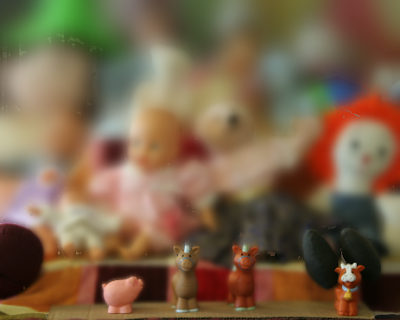I have written a little article in pdf form which compares the performance of DMAG2, DMAG5, DMAG6, and DMAG7 on a set of 9 stereo pairs taken with an HTC Evo 3d cell phone with dual cameras (baseline is about 30 mm). This may help in understanding the differences in depth map quality between these 4 depth map generators which, I think, are the best in the business.
Anyways, here's the link: "A Qualitative Comparison of Selected Automatic Depth Map Generators" by Ugo Capeto.
Automatic depth map generation, stereo matching, multi-view stereo, Structure from Motion (SfM), photogrammetry, 2d to 3d conversion, etc. Check the "3D Software" tab for my free 3d software. Turn photos into paintings like impasto oil paintings, cel shaded cartoons, or watercolors. Check the "Painting Software" tab for my image-based painting software. Problems running my software? Send me your input data and I will do it for you.
Saturday, September 24, 2016
Wednesday, September 14, 2016
Stereo Conversion - Harrison Ford in Raiders of the Lost Ark
The process of converting a 2d image into a 3d image always starts with a 2d image and a sparse depth map (painted in Gimp or Photoshop).
In the following, I am gonna show depth maps generated by DMAG4 using 1 scale and 3 scales. Note that the more scales you use, the slower DMAG4 runs but the fewer iterations needed.
Clearly, the depth map obtained using 3 scales is better than the one obtained using 1 scale. At this point, it's not a bad idea to smooth the depth map while preserving the edges using, for instance, EPS9.
DMAG4 and EPS9 are available at 3D Software. WiggleMaker is WiggleMaker.
In the following, I am gonna show depth maps generated by DMAG4 using 1 scale and 3 scales. Note that the more scales you use, the slower DMAG4 runs but the fewer iterations needed.
Clearly, the depth map obtained using 3 scales is better than the one obtained using 1 scale. At this point, it's not a bad idea to smooth the depth map while preserving the edges using, for instance, EPS9.
DMAG4 and EPS9 are available at 3D Software. WiggleMaker is WiggleMaker.
Tuesday, September 13, 2016
Point Cloud Maker 11 (PCM11)
PCM11 generates a dense 3d point cloud from an image and its associated depth map. I think it can be an useful tool to assess the quality of the depth map. To view the generated dense 3d point cloud, there are several options (probably among many others):
- MeshLab,
- CloudCompare, and
- Sketchfab.
The manual for PCM11 is in the "ugosoft3d-11-x64.rar" archive. It thoroughly explains the parameters that are needed to run PCM11 via the input file "pcm11_input.txt".

Image for which we want to generate a dense point cloud. This image comes from one of the Middlebury stereo data sets. It is called "Art".
Dense 3d point cloud obtained by PCM11 in the sketchfab 3d viewer:
Here is a video tutorial for pcm11:
The windows executable (guaranteed to be virus free) is available for free via the 3D Software Page.
- MeshLab,
- CloudCompare, and
- Sketchfab.
The manual for PCM11 is in the "ugosoft3d-11-x64.rar" archive. It thoroughly explains the parameters that are needed to run PCM11 via the input file "pcm11_input.txt".

Image for which we want to generate a dense point cloud. This image comes from one of the Middlebury stereo data sets. It is called "Art".
Dense 3d point cloud obtained by PCM11 in the sketchfab 3d viewer:
Here is a video tutorial for pcm11:
The windows executable (guaranteed to be virus free) is available for free via the 3D Software Page.
Shallow Depth-of-Field Generator 11 (SDOFG11)
SDOFG11 simulates a shallow depth-of-field lens effect, commonly seen in macro photography. Because the depth-of-field of modern cameras is quite deep (everything in an image looks quite in focus), it is often necessary (long after the picture was taken) to blur areas of an image that were not meant to be in focus. The shallow depth-of-field lens effect is commonly used to give the impression that objects that are large in real life appear small in the processed image. This effect is commonly known as "miniature faking", "diorama effect", or "tilt-shift photography". In Japan, it's called "bokeh" although "bokeh" implies a special treatment is given to highlights.
The manual for SDOFG11 is in the "ugosoft3d-11-x64.rar" archive. It thoroughly explains the parameters that are needed to run SDOFG11 via the input file "sdofg11_input.txt".

Image for which we want to generate a shallow depth-of-field version. This image comes from the Middlebury stereo database and is called "Dolls".
The windows executable (guaranteed to be virus free) is available for free via the 3D Software Page.
The manual for SDOFG11 is in the "ugosoft3d-11-x64.rar" archive. It thoroughly explains the parameters that are needed to run SDOFG11 via the input file "sdofg11_input.txt".

Image for which we want to generate a shallow depth-of-field version. This image comes from the Middlebury stereo database and is called "Dolls".
The windows executable (guaranteed to be virus free) is available for free via the 3D Software Page.
Subscribe to:
Posts (Atom)







